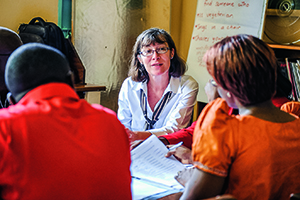“You’ll hear so many people in graduate school say, ‘I took my theory class last semester,’ but we have theory in every class!” says Nancy Pellowski Wiger, a CIDE doctoral student who serves as project director for the Learn, Earn, and Save Initiative. “Then we go out and apply it—to design questions, for example—and bring it back and ask, ‘How is this working?’”

Minnesota’s CIDE program is widely recognized as the strongest in the country for those who seek a balance of theory and applied experience.
That balance can be traced to the program’s founders. Frank Braun was a pioneering exchange scholar in the post-World War II period who became a faculty member in curriculum and instruction, supporting thousands of students in career preparation, planning, and placement. John Cogan was a comparative education scholar with research and teaching experience around the world. R. Michael Paige came from Stanford’s CIDE program and developed tools to prepare students for study abroad and measure its impact. Josef Mestenhauser fled the Cold War in his native Czechoslovakia, led the nation in developing the profession of international student advisers, and challenged a generation to develop the theoretical foundation for education during rapid globalization (read the related story, “All hands on deck”).
In the 1990s, CIDE attracted Deanne Magnusson, a specialist in leadership development and teacher and adult education. Gerald Fry is a scholar whose role in transforming Thailand’s education system is known across Asia. And David Chapman is a top international education evaluator whose newest role is leading a $50 million grant to educate the global workforce on pandemic preparedness.
In the past 10 years, CIDE has gained DeJaeghere, Vavrus, Goh, and most recently Roozbeh Shirazi.
Minnesota on the map
The Twin Cities international and multicultural character has fostered CIDE’s combined strength, with large populations of immigrants, refugees, Native Americans, colleges, and Fortune 500 companies. That environment was a draw for Vavrus.
“We have the largest Liberian and Somali communities in the United States in our metro area,” she says, “an illustration that international is not ‘out there’—it’s right here.”
Vavrus came to Minnesota from Teachers College, Columbia University, in 2008. She jokes that international education is practically in her DNA: her father was a Russian professor, her mother an ESL teacher at Purdue, and she remembers international gatherings in their living room since childhood. In college, she traveled to Tanzania for the first time, began to learn Swahili, and laid the foundation for a lifelong study of education in sub-Saharan Africa.
Matthew Thomas, ’13, met and worked with Vavrus in Tanzania. He was a high school music and band teacher, inspired to get a master’s.
“She had a strong emphasis on teacher education, and I liked the way she did her research—she is truly collaborative,” says Thomas. “Fran knows the theories and can work with people in different contexts to find ways to test and apply them.”
Thomas joined Vavrus at Columbia and followed her to Minnesota, where he worked on the Zambia project as a graduate student.
“The applied project completed by many students in the CIDE program is so valuable,” he says. “It’s fun, and you learn a lot because it’s very practical—it’s what happens in the world in addition to the classroom.”
Today Thomas is working in a tenure-track position at the University of Wisconsin-LaCrosse.
Meanwhile, the government of Tanzania has initiated a project to reform its in-service teacher education program based on Vavrus’s research and work with local professionals in a program called Teaching in Action, a learner-centered approach that grew out of a Fulbright in 2006–07. It’s one example of how the CIDE faculty is working to speed up the path from theory to practice.
“We’re always critiquing our field,” says Vavrus, “but at the same time, we don’t have the luxury of waiting for things to be perfect.”
This story is a companion to the feature story “World classroom.“
See also the comparative and international development education program track.
Story by Gayla Marty | Photo by Jason J. Mulikita, JJArts Photography | Spring/summer 2015